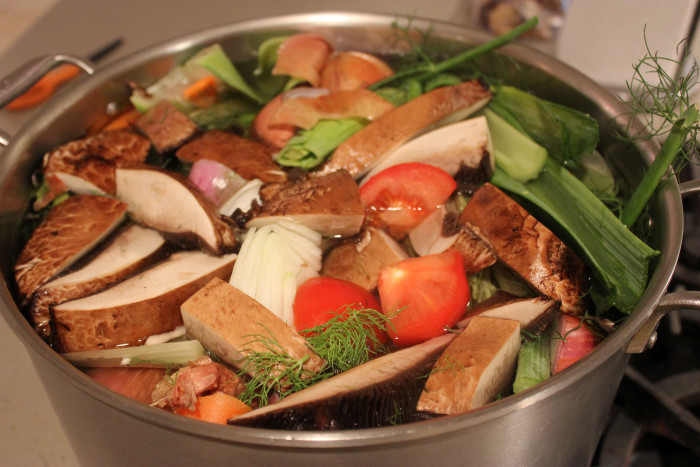Friday in our Tribeca kitchen is stock day. As the workweek ends, Suzen’s cooking school may have had four or more events. Over a hundred people will have cooked, laughed, and dined here. With that many people, you can be sure we have leftovers. And leftovers never go to waste.
We make stock, vegetable stock as you see here, but also chicken and beef stock. We never let a chicken or turkey carcass go to waste. That Thanksgiving turkey will have its bones frozen and then tossed into a pot perhaps months later.
Why stock? It add flavor. Yes, you can use water as a liquid but stock is better. Yes, you can buy stock and you can even pay a premium price for something labeled organic. But the best stock, the one without any additional chemicals or preservatives, is best made by you. With your own still fresh leftovers. And then stored in your refrigerator or freezer.
How do you do it?
Step One: The Ingredients
Scour that refrigerator. You may find half an onion, or an onion that is not going to make four more days. Use everything. Mushrooms, carrots, celery, tomatoes, even herbs that are now orphaned. Wash them all and cut them up into large pieces.
Step Two: The Pot
Fill a large, what else, stock pot with water and add salt. Leave enough room for the veggies to go. Bring just to simmer.
Step Three: The Cooking
Add the veggies, and the bones if you have any, and cook for an hour. Two hours with the liquid evaporating if you want intensified flavor. Keep the lid on for the first hour. You can skim off the top, but you don’t need to.
Step Four: Clean and Cool
Using a strainer lined with cheesecloth, carefully empty your stock pot into a very large bowl. Allow the liquid to cool until warm to the touch but not hot. Divide the stock into plastic containers. Keep the lids off and allow to cool to room temperature. This can take a few hours, so you don’t want to begin this project at 10PM. It’s a 10AM project.
No, you can’t let the containers sit overnight to cool. You’d need a hazmat suit then.
Step Five: Store
Store in your fridge for up to two weeks or freeze for up to six months.
Step Six: Use
We go through hundreds of quarts of stock a year. As a home cook, you’ll use it less but if you keep track you’d be surprised how much stock you can use. Soups and stews, braising meats, creating elegant rice, making that turkey stuffing. You’ll use more than you can imagine. And, homemade, is far superior to store bought. You’ll learn that with your first quart.
And, there’s a side benefit. On Fridays, our Tribeca loft smells like, well, warm stock: rich, nurturing, and inviting.

